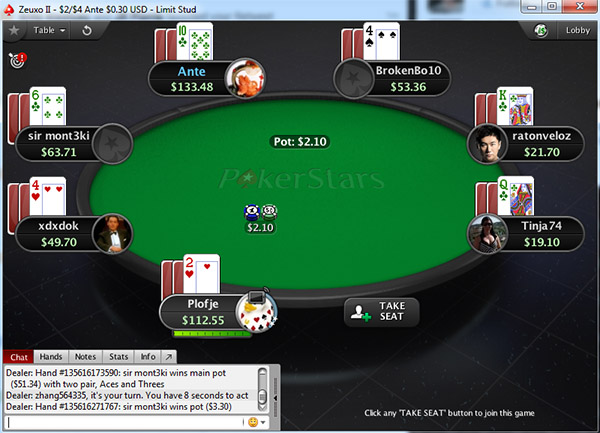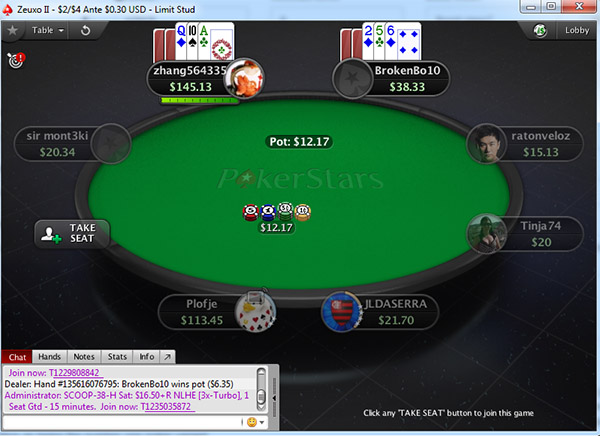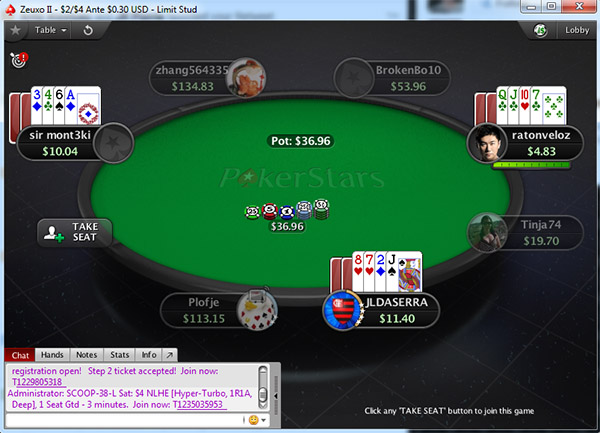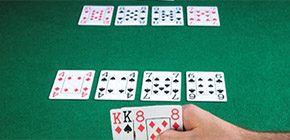Learn to play Stud poker, somewhat forgotten poker variation that doesn't use community cards
Stud History
The
origins of stud poker
are generally attributed to the American military. 3-card stud was popular among soldiers during the American Revolutionary War (1775-1783), whereas 5-card stud first appeared during the American Civil War (1861-1865). In more recent times 7-card stud has become the most popular variant in both casinos and home-games. It was only in the 1980s with the rise in popularity of Texas Hold'em that 7-card-stud fell from its position as being the number one poker variant.
Here are some of main differences in the 7-card-stud variant compared to other poker variants -
- players are dealt a combination of up-cards and down-cards but no community cards
- there are no fixed positions at the table – this will changed based on hand-strength
- there are 5 betting rounds
- antes are taken from all players every round
Stud is generally played as a fixed limit game meaning there are two possible bet-sizings in most situations. The big-bet and the small-bet, with the big-bet being double the small-bet. The antes are considerably smaller than the small-bet. For example if the big-bet is $2 and the small bet is $1, the ante will often be somewhere around $0.15.
Stud can generally be played with 2 up to 8 players. Seeing as each player will receive 7 cards, having more players than this would not be practical.
Stud can generally be played with 2 up to 8 players. Seeing as each player will receive 7 cards, having more players than this would not be practical. In fact, even with 8 players there is a possibility of running out of cards if each player is dealt all 7 cards. This will happen extremely rarely however and there is a special rule which covers this situation.
Keeping Score
Similar to all other poker variants the objective of the game is to win your opponents chips. These are small circular plastic discs which can be exchanged for their monetary equivalent after the game is over. Stud can also be played as a tournament, where the objective is to be the last player left standing with all of the chips.
Playing a hand of 7-card Stud
Before any cards are dealt, all players must pay an ante, placing it into the “pot” in the centre of the table. At this stage each player will be dealt three cards, 2 face-down and 1 face-up so that everyone can see. The two down-cards may be looked at but should be kept secret from the rest of the table. The first round of betting, “third street”, may now take place.
Stud is considered a non-positional game in that there is no dealer button to indicate who will act first. This depends on the strength of the up-cards and can change from street to street.
Third-Street – The player with the lowest up-card acts first, with the action then proceeding in a clockwise direction around the table until both the following are true -
- everyone has acted
- all players have agreed on the amount bet – no additional raising takes place
The player with the lowest up-card is referred to as the “bring-in” and is required to make a starting bet. There are 2 options – a smaller bet or a larger bet. The size of the smaller bet here will depend on the game. The larger bet will be equivalent to the “small-bet” as specified in the game stakes. So in a $1/$2(ante $0.15) game, this will be $1. The smaller “bring-in” amount will usually be around $0.40.

The action proceeds in a clockwise direction around the table where players have the option to either call (match the current bet), raise (increase the current bet), or fold (give up on the hand).
Fourth Street – Each player is dealt another card face-up, referred to as “fourth-street”. The player now first to act is the player whose up-cards are the highest. Highest card wins, although any pair will beat a high card. So holding 77 as up-cards is stronger than holding AQ as up-cards.
The player to act may now check, or bet. Assuming he chooses to bet he must select the small-bet sizing ($1 in the $1/$2 game). Action proceeds in a clockwise direction and players may choose to call, raise, or fold.
Fifth Street – A third card is dealt face-up, referred to as “fifth street”. Once again action starts with the player whose up-cards have the highest value. The main difference with fifth street is that betting will now occur in increments of the big-bet. The initial player to act has the option to check or bet the big-bet amount ($2 in the $1/$2 game).

Sixth Street – A fourth card is dealt face-up. Similar to previous streets the player with the highest value up-cards starts the betting. Betting will continue to occur in increments of the big-bet.

Seventh Street – A final card (7 in total) is dealt face-down. This card may be looked at but should be kept secret from the other players along with the initial 2 down-cards. The player with the highest value up-cards takes the betting lead. This will be the same player who started the action on sixth street, since the 7th card dealt is unknown to other players. Betting occurs in increments of the big-bet. Assuming there are still players left in the pot after the betting is complete then we reach “showdown”. Players must turn over their cards to see who wins the pot. The player who takes the last aggressive action should turn over his hand first.
Hand Rankings
Naturally the above

information is not of too much help if we don't understand how to read the strength of our hand. The following is a list of the hand rankings used in Stud (and many other popular poker variants). Keep in mind that all hands in Stud are comprised of 5 cards. Assuming that we hold the same “pair” as another player, the strength of the remaining 3 cards or “kickers” will be used to determine who wins the pot. In a situation where these kickers are identical then the pot is a tie and will be split up evenly between the winners.
Royal Flush – 10JQKA (T, J, Q, K, A) all of the same suit. This is the strongest hand in stud and is made quite rarely as a result.
Straight Flush – 5 cards in a row, all of the same suit. For example 78910J
Four-of-a-Kind – 4 cards of the same value. For example QQQQ, or 8888. Usually referred to as “Quads”
Full-House – 3 cards of the same value along with 2 cards of the same value. QQQ77 or KKKJJ Often referred to as a “boat”.
Flush – Any 5 cards of the same suit. 36910K
Straight – Any 5 cards in ascending order. For example 7,8,9,T,J but not all of the same suit.
Three-of-a-Kind – Three cards of the same value, for example KKK, or QQQ. Since all hands are 5 card hands the other two cards are referred to as “kickers”. KKQQ7 loses to KKKQJ for example.
Two-Pair – 2 cards of the same rank along with 2 other cards of the same rank. For example KKQQ7 or 101077K
One-Pair – 2 cards of the same rank. For example 99Q73, or JJ1086.
High-Card – Assuming no player has a made hand then the highest card wins. Assuming both players share the same high card, then the second highest card wins, etc.
Fixed Limit betting Structure
It's important to understand the stakes and the betting structure before the action begins. Most stud games are based on a fixed-limit structure which means -
a) we can only bet in fixed increments.
b) there is a cap on how much can be raised to on any given street.
Each betting increment will either be based on the “small-bet” or “big-bet”. These will be described as the listed stakes of the game. So in a $1/$2(ante $0.15) game, the small-bet is $1, the big-bet is $2. In stud games there will be an additional bet-sizing used which is the smallest “bring-in” amount. In a $1/$2 game the bring-in maybe be something like $0.40 but varies from casino to casino.
As mentioned we used increments of the small bet on third street, and fourth street. The exception on fourth street is if our up-cards show a pair, then we have the option to use increments of the big-bet. On the remaining three streets we must use increments of the big-bet.
However in most limit games it is not possible to continue raising indefinitely. There will usually be a cap on the amount of times we can re-raise our opponent on each street. Again this will vary depending on the casino – but it's commonly 1 bet and 3 consequent raises.
The exception on fourth street is if our up-cards show a pair, then we have the option to use increments of the big-bet.
For example on fourth street we bet the small-bet $1. Our opponent raises us by the small-bet to $2. We then re-raise to $3. Our opponent can then raise us one last time to $4. At this stage we will have only the options to call and fold, not to re-raise.
Additional Rules
The community card –

As mentioned earlier it is possible to run out of cards in an 8 handed stud game. This will happen somewhat rarely, but if all 8 players would take 7 cards then 56 cards would be needed and there are 52 cards in a standard check. In such an eventuality the 7th card will be dealt face up on the table and used as a community card. All players may make use of this 7th card to construct a 5-card hand.
Bring-in tie – Assuming there are two players holding up-cards of the same rank, certain suits may be counted as stronger than others for the purposes of a tie-breaker. These are ranked in alphabetical order with clubs being the weakest and spades being the strongest. So if one player holds the 2h and another the 2s, then the 2h has to bring-in and start the action. The ranking of suits is also used to determine who will act first on the following rounds. However it does not affect made hands at showdown – so if we have the same nut-low as someone else, we will chop the pot.
Fourth street pair – While typically betting takes place in increments of the small-bet, players have the option of using the big-bet sizing on fourth street when their up-cards show a pair. This is optional, although once the big-bet sizing is selected then other players must raise in increments of the big-bet.
If a player is all in and can't pay the bring-in, the bring-in moves clockwise to the next player, regardless of his up-card
Can't pay the bring-in – If a player is all-in after paying the ante and are subsequently dealt the lowest value up-card, it is obviously not possible for them to bring-in and start the betting. The bring-in moves clockwise to the next player on the table, regardless of the value of his up-card.
Why play 7-card Stud?
- Some players feel Stud is a more pure game of poker. It certainly has a longer and richer history when compared to more modern variants.
- There is a huge amount of information to base decisions on. We have our own cards + up to 4 up-cards visible for every player at the table. The best decisions in a stud game will involve taking in to account all of the visible cards on the table. This is a large amount of information and can make the game very exciting. This can make stud very difficult to multi-table effectively online, but adds to the richness of the game when played on a single table or live.
- There are many different variants of stud. This can make home games very interesting as different variants of the came can be tried. The cult classic Rounders featured the Chicago variant of stud. Chicago is a split-pot stud variant where a high spade in the hole wins half the pot, splitting with the best made hand.
7-card Stud tips for beginners
- Play hands with the best potential. Our initial 3 cards should show some potential in terms of being able to make a strong 5-card hand. In most cases having more than one card of the same suit is better than having none. Having high cards is also generally better than having low-cards. If our high card improves to a pair it is more likely to be good than if our low card improves to a pair.
- Use your opponents up-cards for information. Our opponents up-cards and generally a window on the strength of their hand. If their up-cards show 4-cards of the same suit and they are betting or raising aggressively then that should be a pretty good indication that our pair is probably no good. Also if our opponents up-cards beat our entire hand then we know we are beat with 100% certainty. For example our opponents up-cards show three-of-a-kind, we should clearly have no problem laying down a lower three-of-a-kind.
- Play hands with live outs. Waiting on spades to make a flush? We can often gauge how likely this is to occur by checking our opponents up-cards. If many of our outs have been dealt as up-cards to our opponent then chasing our draw may not be a wise idea. In some extreme cases all of our outs may be taken. Having a straight draw is no good if none of our outs remain in the deck.
If you found this article helpful you should follow us for more amazing articles about 7-card Stud strategy articles!
You can also check our huge
library of poker strategy article but before that find out which poker variant you like more by reading it's rules at our
Poker Rules page.
 are generally attributed to the American military. 3-card stud was popular among soldiers during the American Revolutionary War (1775-1783), whereas 5-card stud first appeared during the American Civil War (1861-1865). In more recent times 7-card stud has become the most popular variant in both casinos and home-games. It was only in the 1980s with the rise in popularity of Texas Hold'em that 7-card-stud fell from its position as being the number one poker variant.
are generally attributed to the American military. 3-card stud was popular among soldiers during the American Revolutionary War (1775-1783), whereas 5-card stud first appeared during the American Civil War (1861-1865). In more recent times 7-card stud has become the most popular variant in both casinos and home-games. It was only in the 1980s with the rise in popularity of Texas Hold'em that 7-card-stud fell from its position as being the number one poker variant.




